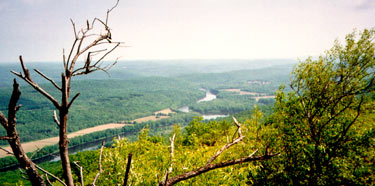Managing Resilient Forests Initiative
Forests in Region 1 parks are in peril.

Forests cover tens of thousands of acres in eastern national parks and these critical resources face a range of interacting stressors: novel pests and pathogens, invasive plant dominance, over-abundant white-tailed deer populations, development of surrounding lands, altered disturbance regimes, increasingly frequent extreme weather events, and changing climate conditions. At worst, these stressors cause the parks’ native forests to be replaced by thickets of exotic invasive shrubs that impede cultural viewsheds and increase visitors’ exposure to disease-carrying ticks. Collectively, these impacts can result in increased operational costs for parks to ensure visitor safety and preserve park infrastructure and have the potential to change the character of a park’s specific resource that visitors have come to enjoy.
Forest health monitoring data from five Inventory & Monitoring (I&M) Networks within NPS Region 1 have identified concerning long-term, region-wide trends in tree regeneration that indicate significant threats to future sustainability of park forests.
Many parks lack the minimum level of seedling and sapling (small tree) density needed to replace canopy trees as they die, whether from age, natural disturbance, or the effects of non-native pests and pathogens. Even in parks where I&M has documented “healthy” regeneration (i.e., seedling and sapling density at levels sufficient to sustain a future tree canopy), the regeneration is composed of primarily non-canopy tree species or species whose future is known to be threatened (e.g., ash trees, which are being decimated by the invasive exotic Emerald Ash Borer). In most parks, non-native plant abundance is increasing which further suppresses regeneration.
Urgent Management Needs
Based on these troubling trends, I&M scientists are concerned that parks in the Eastern U.S. need active management approaches to restore or sustain their forests over the long term.Managing for resilient park forests is imperative to ensure long-term ecosystem health, maintain biodiversity, and meet the NPS mission of preserving park resources unimpaired for future generations.
For More information
Contact:
Stephanie Perles
Vegetation Ecologist, Eastern Rivers and Mountains Network
(814)-441-9643 • Stephanie_Perles@nps.gov
Dowlnoad this Resource Brief




